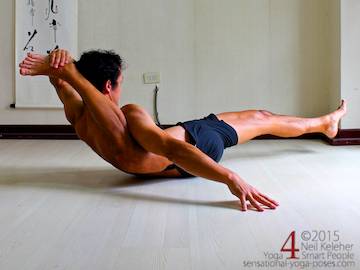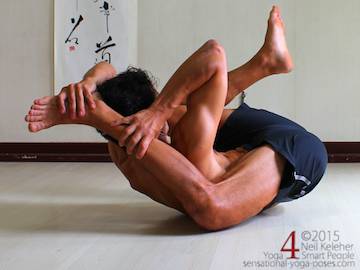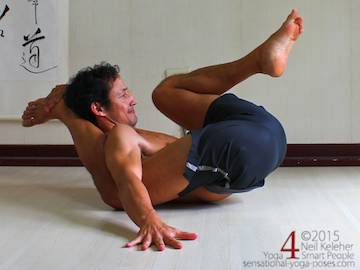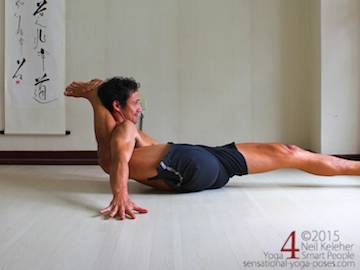Foot Behind the Head
Working Towards Eka Pada Sirsasana Yoga Pose Intelligently and Efficiently
Foot behind the head (eka pada sirsasana) is a yoga pose that I find extremely difficult. And it's one that I avoided for a long time thinking that I really didn't need the ability to put my foot, ankle or shin behind my neck.
I did try working towards it a few times in the past but then gave up because my methods were uncomfortable and didn't help much.
I then decided (perhaps it was after watching some break dancing videos) that I did want to learn. A big part of what keeps me practicing it now was finding a suitable way to prepare for it that is simple, efficient and effective.
Preparing for Eka Pada Sirsasana
As a minimum I like to use happy baby pose to prepare. Try it with head on the floor first and then with head lifted.
Even better is to do a version of pigeon pose prior to happy baby.
One version of pigeon that I'm finding effective is yoga pigeon pose with the front leg hip lifted. Another version is pigeon pose glute stretch.
To make getting the foot behind the head easier I like to work towards it while laying down. Once I'm reasonably proficient in this position, then I'll start working at it while sitting. Another "marker" for progress in this pose is being able to hold the position without holding on to the foot. To that end I feel like there is a balance between using the shoulder to keep the foot in place, and use the head and neck.
Get Your Shoulder In Front of Your Leg
The first step is to get your shoulder in front of your leg. (This is one of the main reasons for using happy baby pose as a preparation.) Once you do, try pressing your shoulder or your elbow down.
Use your arm for leverage.
Also try different grips with your hands. Overhand or underhand, you may find that each offer advantages and that it helps to shift your grip on your foot as you work deeper into the pose.
So that you have more room to move, keep your other knee bent and close to your chest. This makes it easier to bent your spine forwards which in turn makes it easier to get your foot closer to your head.
The next step, keeping your non-stretched leg bent, is to get your foot close to your head. I sometimes wait with my foot near my ear.
Try using both hands to try to pull your shin behind your head. Try to wiggle your shoulder towards the outside of your leg. Then you can use your shoulder or part of your upper arm to push your leg down. Work at relaxing your hip so that you can rotate your leg behind the back of your head.
Once you've seated your foot behind your head or neck, you can let go with the same side arm and reach the hand towards the floor. Keep some tension in the shoulder or arm to help keep your leg in place.
Protect Your Knee from Injury
To protect your knee as you go into, or work towards, foot behind the head, you may find it helps to stiffen the foot and ankle, especially if you are holding on to the foot.
Got Ab Cramps? Try Contracting the Side of Your Waist
To avoid your abs cramping, you may find it helpful to contract the side of the waist on the side that you are stretching. If you are putting your right foot behind your head, contract the right side of your waist.
Reach Your Free Leg Forwards
Once you can get your foot or ankle to the back of your head you can press back with your head to help seat your foot. And to add a bit of weight and tension to the pose reach your free leg forwards.
Rest
Release and rest for a few moments. This is one of the best parts of doing this pose, the feeling afterwards.
Counter Pose
You may find that a natural counterpose to foot behind the head is some sort of back bend for the spine.
I like bridge pose.
Wheel pose, table top or straight bridge may also work.
Published: 2013 04 18
Updated: 2021 03 10







